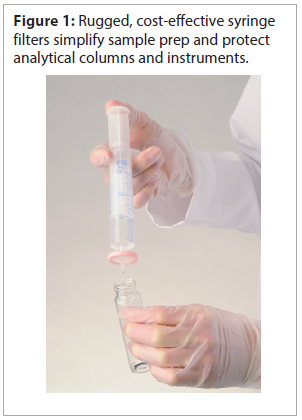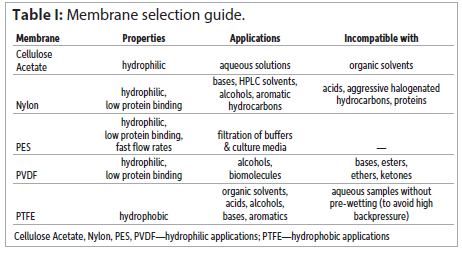01494 563377
Simplify Sample Prep and Protect Analytical Equipment with Syringe Filters

- Cost-efficient, reliable filtration
- Protect analytical column and instruments
- Achieve more reproducible analyses
 The importance of clean sample extracts in maintaining analytical instrumentation cannot be overstated. Particulates commonly found in extracts can quickly damage instrument components, causing costly downtime and repair. Chromatographic columns, injecyots, detectors, and small diameter tubing are easily plugged by particulates. Even if plugging does not occur, the slow accumulation of particles over time can affect flow rates and create interferences that reduce overall reproducibility. Clean extracts will greatly extend the life of costly chromatographic columns and replacement parts, particularly for LC systems.
The importance of clean sample extracts in maintaining analytical instrumentation cannot be overstated. Particulates commonly found in extracts can quickly damage instrument components, causing costly downtime and repair. Chromatographic columns, injecyots, detectors, and small diameter tubing are easily plugged by particulates. Even if plugging does not occur, the slow accumulation of particles over time can affect flow rates and create interferences that reduce overall reproducibility. Clean extracts will greatly extend the life of costly chromatographic columns and replacement parts, particularly for LC systems.
Sample cleanup to remove particulates can be accomplished through the use of inexpensive and easy-to-use syringe filters. These membranes vary in properties and should be selected based on matrix and solvent characteristics (Table I). With a female luer lock inlet and male slip outlet, the syringe filter easily fits onto the end of the disposable syringe containing the sample, as shown in Figure 1. The extract is gently pushed through the filter into a sample vial for injection, removing damaging particulates from the final extract. This connection can be further strengthened by using a syringe with a luer lock tip, creating a more secure connection that can withstand higher filtration pressure.
With a variety of syringe filters available, understanding the role of diameter, pore size, and membrane will aid in proper selection. Sample volume will determine the choice of diameter, ensuring that the filter is not overloaded. Porosity is dependent on application and, in the case of LC, the particle size of the column packing. Tables II and III provide guidelines for selecting filter size and porosity. Use these guides to select the right filter for your application. Investing in inexpensive syringe filters is a cost-effective way to reduce variability and protect expensive equipment.




